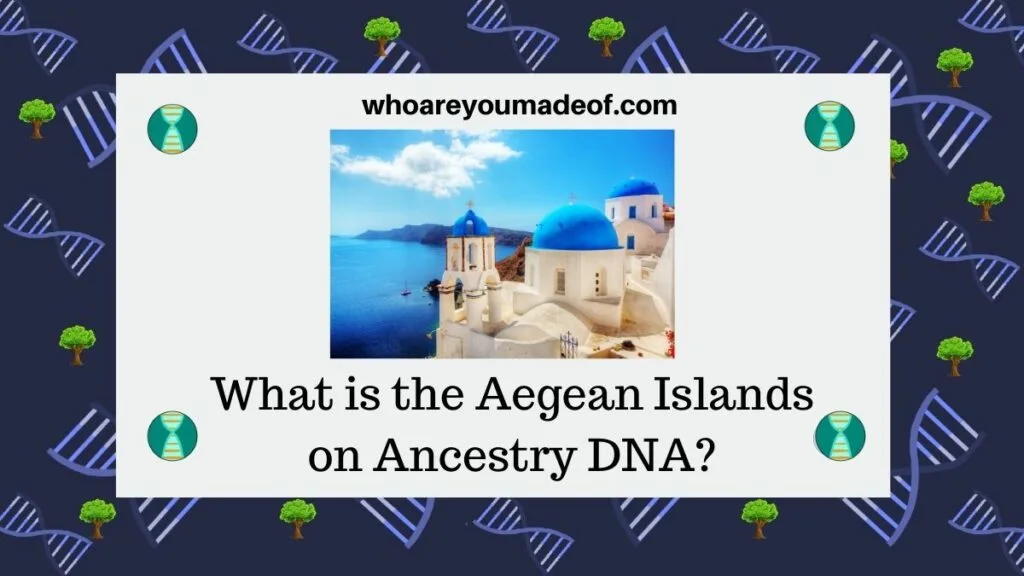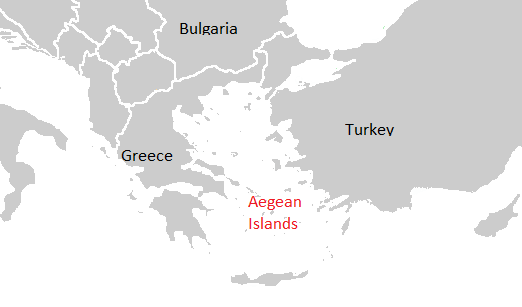Did you get the Aegean Islands in your Ancestry DNA results? In this post, learn how to understand this region in your ethnicity estimate, learn how you may have inherited it, and how to trace your Aegean Island ancestors.
- Where the Aegean Islands DNA ethnicity is located
- Which countries are generally considered part of the Aegean Islands DNA region
- Whether you can find Aegean Islands DNA in other parts of the world
- How to research your Aegean Islands ancestors

The Aegean Islands DNA region, which is under the Europe heading, is new to Ancestry DNA results for 2021. As DNA testing technology improves, Ancestry DNA refines and updates our results, which is exactly how this region was added in September, 2021.
Whether you saw this region in your updated Ancestry results, or if you are a first-time DNA tester with Ancestry, you will be sure to find the answers you are looking for in this post.
Where is the Aegean Islands DNA Ethnicity located?
The Aegean Islands DNA Ethnicity region on Ancestry is located in the similarly-named geographic area in the Aegean Sea between Greece and Turkey. There are more than 1400 islands in the Aegean Sea, some larger than others.
According to Ancestry DNA, the Aegean Islands DNA region covers all of the islands located in the Aegean Sea between Greece and Turkey, including the Greek Island of Ivia, parts of Attica (where Athens is located), as well as the the Western part of the Anatolia region of Turkey. The map below illustrates the Aegean Islands to help you understand where the DNA region is located.

Most of the islands in the Aegean Sea currently are part of Greece, but some are included in what is the country of Turkey. The largest of the Turkish Aegean Islands are Imbros (Gökçeada) and Tenedos (Bozcaada).
Even though these islands fall under the political jurisdiction of two distinct countries, the inhabitants of the region share a unique cultural and genetic history.
In which countries can you find Aegean Islands DNA?
Even though the Aegean Islands DNA region is located in the Aegean Sea, we might find people with ancestry from this area in other parts of Europe or West Asia. We are most likely to see people with ancestry from the Aegean Islands in neighboring regions due to the normal movement of people because of economic and political reasons.
The regions that neighbor the Aegean Islands DNA region are:
- Greece
- Turkey
This means that if you have been building your family tree and you know that you have ancestors from Greece or Turkey, you might have inherited your Aegean Islands DNA through those Turkish or Greek ancestors. It is also conceivable that people with ancestors from the Balkans region might have ancestors from the Aegean Islands.
How did you get Aegean Islands DNA?
Those who have Aegean Islands DNA on their Ancestry ethnicity estimates likely have an ancestor who lived the region. We can show DNA from very distant ancestors on our results, which means that your Aegean Islands ancestors may be very far back in your family tree.
If you have relatively recent ancestry from the region, or if you have a large number of more distant ancestors from the same area in the Aegean Islands, you might find that you received a more specific sub-region on your ethnicity estimate.
As of March 2024, the sub-regions for the Aegean Islands are as follows:
West Anatolia and Aegean Islands
- Crete
- Dodecanese
- East Central Aegean Islands
- North Aegean Islands
- West Central Aegean Islands
If you know that you have ancestors who lived in any of the sub-regions, but you didn’t receive it on your ethnicity estimate, don’t worry. It does not mean that your family tree is incorrect.
Instead, it simply means that you did not inherit much DNA from the ancestors from the sub-region, or your ancestors had more DNA from neighboring regions. Both of these scenarios are more likely when researching more distant ancestors.
How to trace your ancestors from the Aegean Islands?
If you are interested in tracing your ancestors from the Aegean Islands, you can do so, even if you don’t know for sure how far back to look for your Aegean Islands ancestor. Our ethnicity estimates can provide us with a guideline where how and where to do research, but the best strategy available to you is building a family tree.
The first step to identifying who your Aegean Island ancestors may have been is to build a basic family tree using information that you might already have access to. For example, names and years of birth of your parents and grandparents can help you easily identify who your great-grandparents were.
Once you know these basic details about your recent ancestors, you can start entering this information into an online family tree that you can build on many websites for free, like on Ancestry. You might discover that a great-grandparent or great-great grandparent was born in, or had ancestry from, one of the Aegean Islands countries (Turkey or Greece), or one of the neighboring regions that I mentioned previously in this article.
If you find that you do not see any evidence of an ancestor directly from Turkey or Greece, you still have more options available to you. You can continue to build your family tree further back until you discover more about your Aegean Islands roots.
You might also find that the strategy of analyzing your DNA matches and using your matches to build your family tree is key to discovering your family’s roots in the Aegean Sea region.
Conclusion
I hope that this post has helped you learn more about your Aegean Islands DNA, especially how you may have inherited it and how to learn more about your ancestors from these beautiful islands. If you have any questions about something that you read in this post, or if you would like to comment about your own results from this region, please join us in the discussion below.
Thanks for stopping by and reading today!

Marena Arbelia
Saturday 4th of December 2021
My grandpa and his first family lived on Tinos. But I have no information as to where he met MY grandma, his second wife, or where she was from. Is there a way to get records on his first family...thise "kids" would be half relatives. An DC I have no information on my grandma other than her maiden name. Can you help?